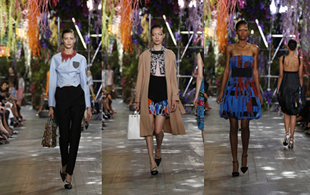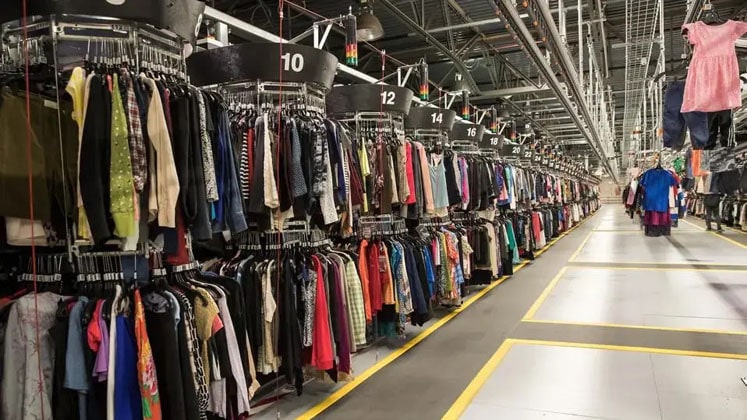FW
 REPORT_ Salvatore Ferragamo consolidated revenues for the fiscal year 2013 were up by 9 percent at current exchange rates and by 11 percent at constant exchange rates versus financial year 2012. All geographical areas, with the sole exception of Japan, registered in financial year 2013 a double-digit growth in turnover. The Asia Pacific area is confirmed as the group’s top market in terms of revenues, representing about 37 percent of the total in financial year 2013. A major contribution was given by the retail channel in China, which recorded a 20 percent growth compared to the same period in 2012.
REPORT_ Salvatore Ferragamo consolidated revenues for the fiscal year 2013 were up by 9 percent at current exchange rates and by 11 percent at constant exchange rates versus financial year 2012. All geographical areas, with the sole exception of Japan, registered in financial year 2013 a double-digit growth in turnover. The Asia Pacific area is confirmed as the group’s top market in terms of revenues, representing about 37 percent of the total in financial year 2013. A major contribution was given by the retail channel in China, which recorded a 20 percent growth compared to the same period in 2012.
Europe posted an increase in revenues of 13 percent, compared to the same period in  2012. Double-digit revenue growth was recorded also in North America, with an increase of over 12 percent in financial year 2013. The Japanese market showed an increase in revenues of one percent in financial year 2013. Revenues in Central and South America showed an increase of 15 percent. Salvatore Ferragamo is based in Italy. The group is active in the creation, production and sale of shoes, leather goods, clothing, silk products and other accessories, as well as women’s and men’s perfumes. The group’s product range also includes eyewear and watches, manufactured by licensees.
2012. Double-digit revenue growth was recorded also in North America, with an increase of over 12 percent in financial year 2013. The Japanese market showed an increase in revenues of one percent in financial year 2013. Revenues in Central and South America showed an increase of 15 percent. Salvatore Ferragamo is based in Italy. The group is active in the creation, production and sale of shoes, leather goods, clothing, silk products and other accessories, as well as women’s and men’s perfumes. The group’s product range also includes eyewear and watches, manufactured by licensees.
As of December 31, 2013, the Salvatore Ferragamo group’s retail network consisted of 360 Directly Operated Stores while the wholesale and travel retail channel included 264 Third Party Operated Stores as well as a presence in major department stores and high-end multi-brand specialty stores. In financial year 2013 the retail distribution channel posted consolidated revenues up by 9 percent compared to the same period in 2012. The wholesale and travel retail channel delivered an excellent performance in financial year 2013 growing 14 percent.
 ANALYSIS_LVMH took Paris bourse by storm Friday after the world largest luxury goods group hit the 6 billion euros annual profit landmark for the first time. The 2 percent rise in profit for the full year boosted the stock by nearly 7 percent to 131 euros. LVMH was a winnerFriday, not only in terms of full-year profit, but also on the trading floor. The shares advanced as much as 6.9 percent, the sharpest intra-day gain since May 10, 2010.
ANALYSIS_LVMH took Paris bourse by storm Friday after the world largest luxury goods group hit the 6 billion euros annual profit landmark for the first time. The 2 percent rise in profit for the full year boosted the stock by nearly 7 percent to 131 euros. LVMH was a winnerFriday, not only in terms of full-year profit, but also on the trading floor. The shares advanced as much as 6.9 percent, the sharpest intra-day gain since May 10, 2010.
The French luxury giant got an important push from its fashion and leather-goods  divisions, which sales rose 7 percent on an organic basis in the final three months of the year. Growth accelerated from 4 percent in the first nine months of 2013, after a weaker third quarter. Sales for the year came in at 29.1 billion euros, that is it a 4 percent on the previous year. Profit reached 6.021 billion pounds, a record amount that came in 2 percent up year-on-year.
divisions, which sales rose 7 percent on an organic basis in the final three months of the year. Growth accelerated from 4 percent in the first nine months of 2013, after a weaker third quarter. Sales for the year came in at 29.1 billion euros, that is it a 4 percent on the previous year. Profit reached 6.021 billion pounds, a record amount that came in 2 percent up year-on-year.
Despite the green sprouts, market remains cautious, as although the results showed improvement in the fourth quarter of 2013, the annual sales growth remained below the previous year´s.
Commenting the results, the group reminded that, in order to improve performance and turnover, LVMH has launched a more expensive range of "very high quality leather products" where it today said "profitability remains at an exceptional level."
LVMH shares hit 3-year record high in Paris
The improved performance of the unit was the "main positive" in yesterday's full-year results, Rogerio Fujimori, an analyst at Credit Suisse, said in a note.
LVMH shares gained nearly 7 percent on the positive outlook and reverted thus the last twelve months´ 7.6 percent fall due to slowing luxury-goods sales in Asia.
Profit from recurring operations climbed 2 percent to 6.02 billion euros, in line with the median of 19 analysts' estimates compiled by Bloomberg. Similarly, total 2013 revenue advanced to 29.15 billion euros. Analysts predicted 29.4 billion euros. Sales rose 8 percent on an organic basis, matching estimates.
"Despite an uncertain economic environment in Europe, LVMH is well-equipped to continue its growth momentum across all business groups in 2014," the company said.
Kingpins will be organizing its maiden denim trade show at Amsterdam on May 7, 2014. This is its first show at this venue. So far there have been editions at places like New York, Bangalore, Los Angeles and Hong Kong, New Delhi, Hong Kong. It may be known that the Netherlands has the biggest density of denim brands in the world.
The first two days will focus on the business-to-business side of denim. The following two days will include consumers with pop-up shops, laser-finishing workshops, a vintage market, and parties and events for denim lovers and addicts.
The invite only Kingpins Show started in 2004 for the denim supply chain and facilitates networking and relationship-building. The exhibitors list include chemical companies and fiber companies who have new, innovative products, denim and sportswear fabric mills from the US, Japan, China, India, Morocco, Mexico and Europe, wash houses, full package manufacturers, trim providers and business solutions.
Kingpins is about casual wear: jeans, denim, garment dyeing, cotton and fibers. The show attracts global leaders like the best global fiber producers, denim mills, the best piece dyed producers, the chemical companies, industrial laundries, sewing factories, hardware companies and label manufacturers. <br/>
www.kingpinsshow.com/
Sri Lanka’s apparel exports in 2013 reached an all-time record of $4.3 billion compared to $3.8 billion dollars in 2012. The country expects to be among the top 10 apparel exporters of the world by 2020. The Sri Lankan government is offering various incentives where by Sri Lankan entities can now place orders in other low cost bases in the region, bring back to Sri Lanka, add value and export. Multi country consolidation which is offering enormous opportunities is also now possible. A free trade agreement has been proposed with China.
Sri Lanka’s apparel export industry is the country’s primary forex earner accounting for 40 per cent of total exports. There are around 350 garment factories and around 16 textile and fabric manufacturing units. Apparel categories include: sportswear, lingerie, lounge wear, bridal wear, work wear, swim wear, children’s wear. The US and the United Kingdom have historically been the largest buyers of Sri Lankan apparel throughout the decades.
The apparel industry prides itself on the fact that it doesn’t employ children. It has implemented ethical sourcing and sustainable eco-friendly development practices. It aims to empower women and support their communities through poverty alleviation and offering opportunities for education and personal growth. The endeavor is to make the ‘Made in Sri Lanka’ label synonymous with quality, reliability and social and environmental accountability.
EDANA and INDA, the leading international trade associations for the nonwovens and engineered fabrics industries based in Europe and North America, have announced they will harmonize their mission and vision to advance the success of their member companies. A statement from INDA said, “Responding to the needs of each association’s member companies, including those companies that belong to both organizations, this new initiative was drawn from the values and missions pursued by both associations over their more than 40 years of operation.”
“INDA and EDANA have kept parts of each association’s individual positions that are essential to their own nature and character, and have formed a mutual position that not only strengthens the relationship between the two associations, but seeks to provide cohesion and consistency on a global basis. Each organization will continue to operate independently.”
Members of both global organizations are involved in the complete nonwovens supply chain from raw materials, machinery and equipment to roll goods, converters and end products. The services provided by each association are similar in nature, but are said to be unique in delivery and influence. Both associations provide services in product stewardship (safety standards, test methods and sustainability); government and regulatory affairs; commerce and innovative industry events; industry awareness and trust; and training, education and market research.
EDANA serves more than 240 companies across 36 countries in the nonwovens and related industries, helping its members to design their future. Whereas, INDA, the Association of the Nonwoven Fabrics Industry, serves hundreds of member companies in the nonwovens and engineered fabrics industry doing business globally. Since 1968, INDA events have helped members connect, learn, innovate and develop their businesses.
www.inda.org
In his address at the annual meeting of the International Foundation of Fashion Technologies Institutes (IFFTI) in Tokyo, IAF Secretary General Han Bekke urged the fashion industry to rethink its business model. The apparel industry worldwide is still focused on price, which in some cases leads to dramatic situations like last year in Bangladesh.
“The economic situation in important markets for apparel has a negative impact on consumer spending on clothing”, Bekke said, adding, “feeling also the intense competition from fast fashion models, fashion retailers often react with mark downs with heavy pressure on margins as a result. The question where can I produce the cheapest is then asked more often than how can I serve the consumer best. This is no longer sustainable and kills creativity and innovation.”
In Bekke’s view more cooperation in the supply chain is needed. “Rethink your business model”, he suggested when it comes to fast fashion versus slow fashion. “The sector should focus more on value and service and should be more open to innovation. Business models should be based on global responsibility and more transparency,” he opines.
“The apparel supply chain is based on series of human behaviour and behaviour is taught. In IAF’s view educational institutes have therefore a major part to play here in order to prepare new generations for the future challenges of the sector. In their curriculum, fashion universities should pay more attention to calculation methods, planning, global responsibility, ways of communication in the supply chain, chemistry and software,” Bekke told his audience consisting of deans, professors and lecturers from IFFTI’s membership.
Iaf.net.eu
www.iffti.com
ITMA 2015 will be held November 12 to 19, 2015, Milan, Italy. This is the only exhibition worldwide featuring the largest and most comprehensive range of textile and garment technology products and services in one venue.
The fiber and yarn section has over the years got a lot of attention. Fiber and yarn producers have an integrated business platform. It attracts an international pool of buyers sourcing for end-to-end solutions for production of traditional textile materials. This section debuted at ITMA 2011. And ITMA 2015 will increase its focus on recycled fibers and yarns, a move said to be motivated by a growing commitment in the clothing and textiles industry to increasingly invest in environmentally friendly and sustainable production methods.
ITMA has been the world’s most established textile and garment machinery exhibition since 1951. The show is held every four years in alternating European countries. ITMA 2015 returns to Milan after a gap of 20 years. Milan will use the opportunity to reaffirm the quality of Italian products, which are well known for their high level of technology content, reliability and creativity. Italy’s textile machinery exports account for 78 per cent of its total sales and are shipped to around 130 countries.
www.itma.com/
Mills in China have lowered their demand for imported cotton this year because of fears that Beijing will issue fewer import quotas this year. China is the world’s top buyer of cotton. For three years, the country was stockpiling program. Now it wants to encourage consumption of its huge domestic stockpile of fiber at the expense of imports.
Right now, its cotton reserves are about 12.7 million tons, equivalent to almost 60 per cent of global stocks. With so much in reserves, the government is unlikely to issue more import quotas. So there is a strong urge for Beijing to de-stock. Without offering quotas, demand at reserve sales would be tepid. Prices have dropped below 17,000 yuan per ton but that price is 17 per cent less than the reserve's current purchase price.
Imports of Indian cotton for instance are expected to fall from February. What happens next depends on whether China releases additional quotas in subsequent months. But China has already imported several thousand tons of cheap Indian cotton.
In the absence of sufficient import quotas, mills could turn to yarn instead. Imports of yarn are not restricted by quotas and are subject to low import duties.
With the onset of rains, farmers in Ethiopia are set to plant genetically modified (GM) cotton seedlings. This is part of the government’s strategy to boost textile and garment exports.
Ethiopia has embarked on an ambitious five-year economic plan to boost textile and garment exports to meet a target of $1 billion by 2015. Ethiopia exports both cotton fabric and cotton garments.
The hope is that GM cotton will achieve higher yields than conventional varieties. GM crops are also supposed to be more resilient in the face of climate change. In some instances GM crops have not shown to have any negative ecosystem or environmental impacts. But there are activists who oppose the use of genetically modified technology in food production. They say conventional R&D can improves the productivity of locally adapted crops. They say conventional breeding programs can be devised to produce robust improved seed with greater genetic tolerance to heat stress, colder temperatures, drought and water logging. Bt cotton growers in India, in Tamil Nadu in particular, have suffered major losses from a new, unknown disease that has attacked their crops.
In December 2013, Pakistan’s textile exports increased by 22.4 per cent, despite slow economy. Perhaps what contributed to this upturn is the constant energy supply the government guaranteed, especially in Punjab. The current textile export rate is meeting government’s targets. If uninterrupted energy supply is continued, estimations are that Pakistan will be able to double its textile exports over four years. However, the refunds from the government need to be improved to reach the set goals.
In the first half of 2013 (July-December) Pakistan’s textile and clothing exports improved by 8.36 per cent. In terms of added value, particularly bedding witnessed a rise of 21.72 per cent, knitwear 5.35 per cent, readymade garments 7.9 per cent, cotton cloth 6.1 per cent and export of made ups went up 18.09 per cent. On the other hand the export of cotton yarn declined by 3.1 per cent. Total export proceeds grew by 5.11 per cent.












